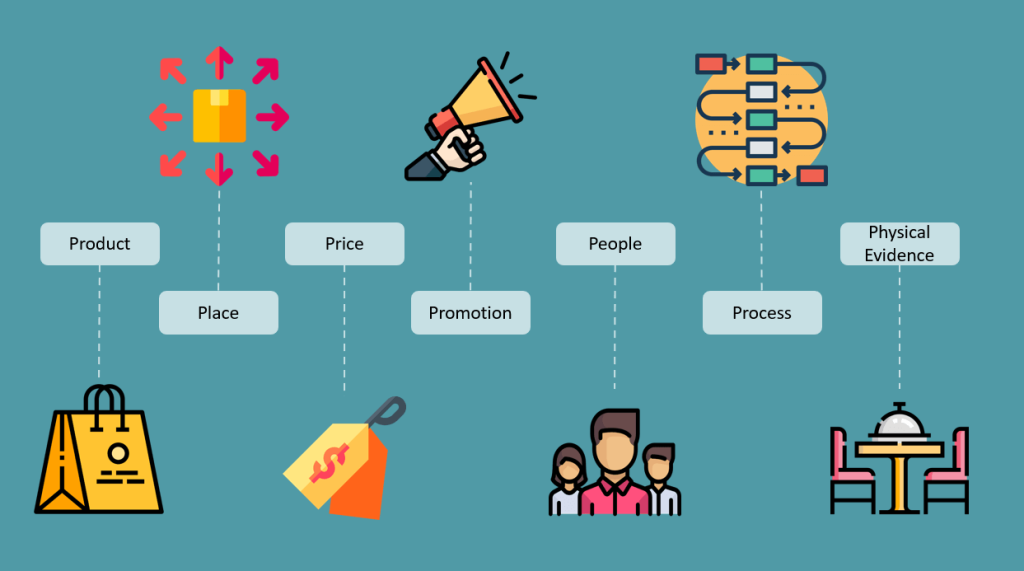If you’re familiar with the 4Ps, then the 7Ps in marketing are likely not a new concept. It’s an incredibly powerful tool in marketing, especially for businesses in the service industry.
So, what are the 7Ps in marketing, and how can you apply them effectively? Let’s explore the key points together.
1. What are the 7Ps in marketing?
The 7Ps model is an extension of the original 4Ps model, incorporating additional elements to better suit businesses, especially those in the service sector.
The 7Ps model includes the following elements:
- Product
- Price
- Place
- Promotion
- People
- Physical evidence
- Process
This model is considered essential for all service-oriented businesses. Let’s delve into each element to understand its significance and strength.

2. Product:
In the service industry, products are largely intangible. For example, in tourism services, customers can only experience but not physically possess the service.
Customer satisfaction with the service experience is the measure of service quality.
To succeed with this first “P,” you need the following strategies:
- Identify your target customer profile and market segment.
- Highlight your unique selling proposition (USP) compared to competitors.
- Regularly listen to and engage with customers.
3. Price:
Among the 7Ps, price is the only factor that generates revenue for the business.
Therefore, you need to consider setting an appropriate price. Some pricing strategies to consider include:
- Market penetration pricing: Setting low prices initially to capture market share, typically for products with little differentiation from competitors.
- Competitive pricing: Assessing the competitiveness of competitors to determine an appropriate pricing level.
- Skimming pricing: Setting high prices to maximize profit initially, then gradually lowering prices to attract more customers.
- Cost-based pricing: Calculating product costs and adding a desired profit margin to determine the final price.
- Value-based pricing: Setting prices based on the value customers are willing to pay for the experience.
4. Place:
Distribution channels in the service sector are crucial. For example, for a children’s English learning center, their customers are usually parents within a 3km radius. Therefore, locating the center in densely populated and convenient areas is essential.
Additionally, for online service distribution channels, factors such as connectivity, user interface, and online experience need to be considered.
5. Promotion:
In today’s competitive environment, promotion is a heavily invested tool for businesses. Typical promotion strategies include discounts, public relations, and advertising.
Businesses need to be judicious in choosing the appropriate methods to avoid excessive costs that may eat into revenue.
Consider the following factors:
- Timing for promotional activities.
- Impact of promotions on brand perception.
- Budget allocation for promotion.
- Understanding customer needs and desires.
- Monitoring and measuring the effectiveness of promotions.
6. People:
In services, people play a crucial role in influencing service quality. Inconsistent service quality can often be attributed to human factors.
To ensure consistency in the service process and provide the best customer satisfaction, you need to ensure quality personnel. Some suggestions for improving personnel quality include:
- Establishing structured training processes for employees.
- Implementing systems for monitoring, supervision, and evaluation of quality.
- Inspiring employees with product and brand enthusiasm.
7. Physical evidence:
Factors such as the aroma of freshly brewed coffee, neatly arranged tables and chairs, and open spaces with natural light are seemingly simple but crucial elements in the customer experience.
To increase customer satisfaction, you need to observe and manage factors such as physical facilities, decoration, color schemes, aromas, and behind-the-scenes elements.
8. Process:
For service businesses, a simple, streamlined, and clear process is crucial.
Complex and time-consuming processes negatively impact the overall customer experience, especially when customers are in a hurry.
Some ways to optimize processes include:
- Eliminating unnecessary steps.
- Ensuring sufficient staffing levels to execute service processes.
- Ensuring materials are readily available for service.
- Encouraging customer participation in some process steps.
9. Starbucks – The coffee giant’s success with 7Ps in marketing
As the world’s most valuable beverage brand, Starbucks is a testament to the resounding success achieved by seamlessly integrating the 7Ps in marketing.
Originally just a small coffee shop, Starbucks’ philosophy of selling experiences rather than just coffee, coupled with relentless marketing efforts, has led to over 18,000 stores in 49 countries.
- Product: Agile in innovation, Starbucks introduces numerous seasonal product lines. They also diversify into complementary products, which are highly sought after.
- Price: Starbucks opts for a premium pricing strategy, based on the customer experience.
- Place: Starbucks primarily offers its products through coffee shops, with some distribution through online channels.
- Promotion: Starbucks invests heavily in advertising, promotions, and loyalty programs to drive sales growth.
- People: Starbucks prioritizes employee training and development, creating an inclusive and diverse workplace.
- Physical evidence: Starbucks’ café designs aim for customer comfort, from the aroma of coffee to personalized decor.
- Process: Starbucks ensures a professional, friendly, and efficient service process, starting with a warm greeting and ending with a fond farewell.
Conclusion on 7Ps in marketing
The above are basic definitions and suggestions to help businesses better apply the 7Ps in marketing mix. Hopefully, these insights will spark new ideas for your business.
Cre: cleverads



















































































































































